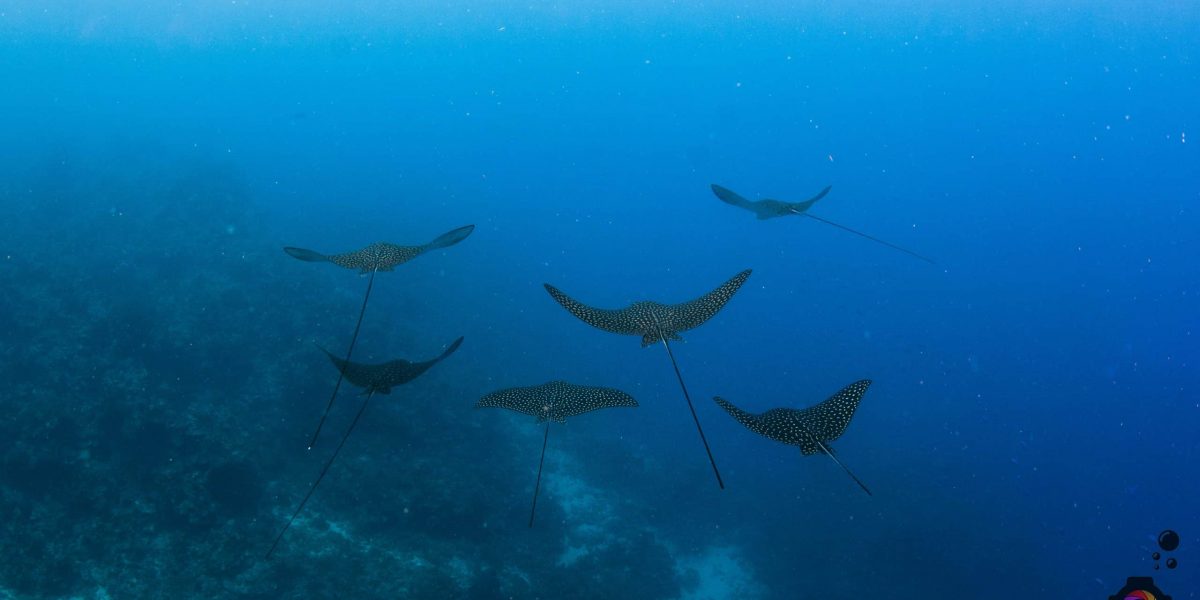Roatan, Honduras is a world-renowned scuba diving destination. Its location on the edge of the world’s second largest barrier reef system allows scuba divers easy access to some of the most abundant marine life ecosystems on the planet. And if you’re fascinated by sharks, Roatan will certainly fulfill your enthusiasm. Honduras dedicated all its coastal waters to the first shark sanctuary in the Americas. Here, you’ll find a variety of marine life ranging from turtles to seahorses to nudibranchs to string raysvand more. But the best way to top off a Roatan scuba diving bucket list: seeing a hammerhead shark (which is somewhat of a rare treat) or seeing one of our favorite creatures that is more common, a Spotted Eagle Ray.
Physical Traits of The Hammerhead Shark
Hammerheads are one of the most instantly recognizable sharks because of their mallet-shaped heads. The great hammerhead can grow up to 20 feet long and weigh in at 1000 pounds. They can live for up to 30 years. Hammerheads have better eyesight than most sharks because of the wide placement of their eyes on their heads. The head is also the location of specialized electroreceptors, known as ampullae of Lorenzini, which allow the hammerhead to detect electrical fields of its prey.
Where Have Hammerhead Sharks Been Sighted in Roatan?
Hammerheads have been sighted all around the island of Roatan. More sightings appear to have occurred around the west end and north shore, but this may have more to do with the number of divers in those areas than the actual number of sharks. Encountering the hammerhead in Roatan also seems to be somewhat dependent on luck as there haven’t yet been any definitively recognizable tracking trends. However, part of this may have to do with the fact that hammerheads aren’t too keen to get too close to humans.
What Types of Hammerhead Sharks Have Been Sighted in Roatan?
The majority of hammerhead shark sightings in Roatan have been scalloped hammerheads and great hammerheads. Scalloped hammerheads have a notched, rounded and shovel-shaped head whereas the great hammerhead has a classic T-shaped head. Both are typically a greenish-tinged gray with white bellies. This allows them to stealthily attack their favored prey (stingrays) from above.
Spotted Eagle Rays
A more common and also thrilling scuba sighting in Roatan is the Spotted Eagle Ray. This majestic creature can grow up to 3.5 meters wide and be up to 9 meters in length. Their lifespan can be up to 25 years.
Female Eagle Rays are larger than males and when they lay eggs, they carry them until they mature and hatch inside their mother and are typically born with a wing span of about 12 inches.
Eagle Ray Facts

A really neat fact about Spotted Eagle Rays is that their spotted pattern on their back is unique – like a human fingerprint.
Another interesting fact about Eagle Rays is that they can sense electric energy. Marine animals produce electrical signals and Eagle Rays can detect those signals to find prey. An Eagle Ray’s snout has a cluster of jelly filled pores that is very sensitive to electrical signals, allowing them to sense when prey is near by or even buried in the sand.
Eagle Ray Jumping
Spotted Eagle Rays are also known to jump out of the water. Sometimes while watching the sunset in Roatan, you may see a large splash in the ocean – which likely could be an Eagle Ray. They have been known to sometimes jump out of the water and onto boats.
Scientists have speculated that the reason Eagle Rays jump out of the water may be either females trying to avoid unwanted male attention, or to shake off parasites and remoras in addition to just jumping for fun.
Roatan Scuba Diving Bucket List
Have you ever seen a Hammerhead Shark or Spotted Eagle Ray while diving in Roatan? What is on your bucket list to see? Let us know in the comments!

